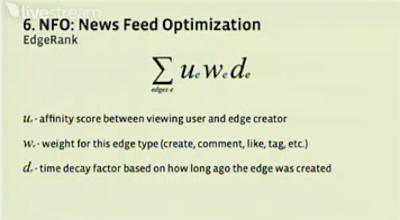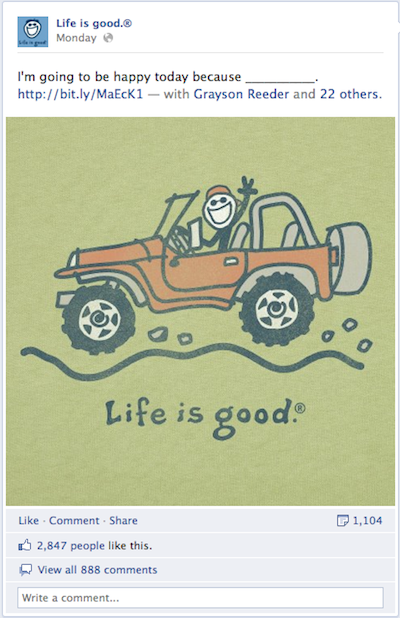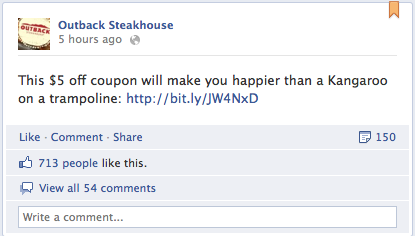 Getting your content seen on Facebook is likely considered by many to be the holy grail of Facebook marketing. And EdgeRank plays a big role. As you may already know, there’s a science to Facebook visibility—and that’s where the EdgeRank algorithm comes in. Understanding the algorithm and what it means is an important step when it comes to increasing not only the visibility of your Facebook content, but also, by extension, your content’s reach.
Getting your content seen on Facebook is likely considered by many to be the holy grail of Facebook marketing. And EdgeRank plays a big role. As you may already know, there’s a science to Facebook visibility—and that’s where the EdgeRank algorithm comes in. Understanding the algorithm and what it means is an important step when it comes to increasing not only the visibility of your Facebook content, but also, by extension, your content’s reach.
Thanks to some recent resources I’ve used, including attending the digital media conference BOLO 2011, I’ve learned a thing or two that I’m not sure the average Facebook user is aware of. So if you work in Facebook marketing or are otherwise tasked with running a business or brand’s Facebook page, this info’s for you!
What is EdgeRank?
EdgeRank is the formula that Facebook uses to decide which posts show up in a user’s NewsFeed and how often. Wait—you thought all of your Facebook fans could see all of your posts? Or most of them, at least? Truth is, that depending on how many fans you have, as little as 10-25 percent of them are seeing your updates, according to stats compiled by PageLever. That’s because Facebook tries to show the most popular, most relevant and bestest stuff in the news feed. And that’s what EdgeRank is all about.
Let’s start at the beginning. First, when you post a comment, a photo, a video or a link, it’s called an Object. When users interact with that Object (comment, share, like…) it’s called an Edge.
Next, there are three basic elements in the EdgeRank recipe.
- Affinity Score. The Affinity Score measures relationships based on interaction. You’ll have a higher affinity score with a close friend with whom you interact on Facebook more than you will with that old high school friend you friended but barely remember. If you’re commenting on a lot of Starbucks’ posts, for example, you may have a higher affinity score than another fan who never interacts with Starbucks. This might mean that you see Starbucks’ posts more often than other fans do.
- Weight. After the Affinity Score, Facebook measures the Weight of an Edge. It’s likely that a comment or a share carries more weight than a like.
- Time. Time is always a factor. As the Edge (remember, that’s the object or link you posted) gets older, it becomes less relevant and loses a little of its EdgeRank.
How to Increase Your Content’s Edge
Now that you understand how content visibility is determined, try these tips to help your Facebook content get more edge—which, in other words, means more eyeballs.
- Write short questions (less than 60 characters).
- Use “Fill in the blanks”.
- Provide value with items like coupons. (But don’t overdo special offers!)
- Rich media helps. A lot. Photos and videos generally outperform links, regardless of your page’s industry or type.
- When posting pictures, post either one or four or more at a time. (Posting two or three doesn’t look so great in the new Timeline, but a group of four or more will get more attention in your fans’ news feeds.)
- Opt for brand-related content rather than introducing unrelated information.
- Every now and then, throw in a video of a mouse in a beer bottle. Trust me on this one. Sometimes you just need to give your community something to laugh about.
- Post when you see action on your last post start to drop off. That’s usually a good indication that it’s fallen out of most of your fans’ news feeds.
Here’s something else to consider. Let me ask you two questions. One: How many pages are you a fan of? The average answer is probably somewhere between five and 20. And two: In the past six months, how many of those pages have you visited? One, two, zero? The truth is that most fans don’t go back to a Facebook page once they’ve liked it. It’s fine to spend time creating custom apps that will help you take advantage of Facebook Timeline and give your fans more options when they do visit your page. But just as important (and maybe even more so), you’ll want to focus your time on adding fantastic content that your fans will want to interact with so that you can get your brand into their news feeds as often as possible.
What have I missed? Have you found what you think is the secret sauce to engagement in your Facebook community? If so, let’s hear it.
 David McBee writes the blog, “Let’s Translate. Making Sense Out of Internet Gobbledygook” where he explains complex internet marketing strategies using easy to understand lingo and analogies.
David McBee writes the blog, “Let’s Translate. Making Sense Out of Internet Gobbledygook” where he explains complex internet marketing strategies using easy to understand lingo and analogies.
Lead image via {Guerilla Futures | Jason Tester} via Creative Commons



